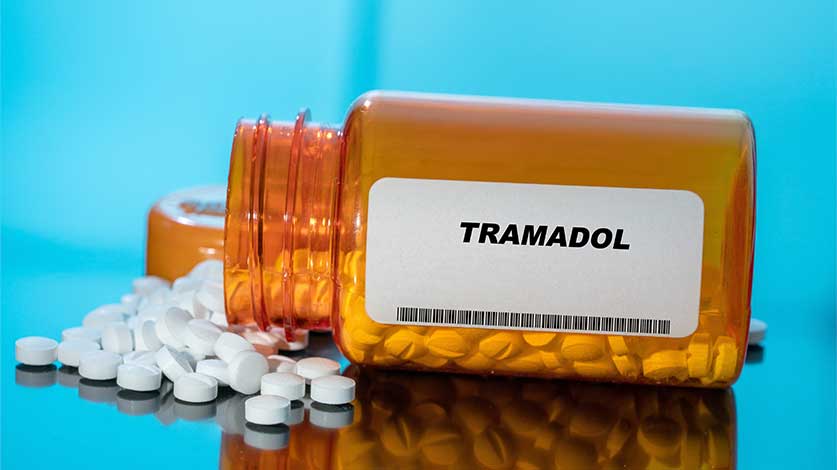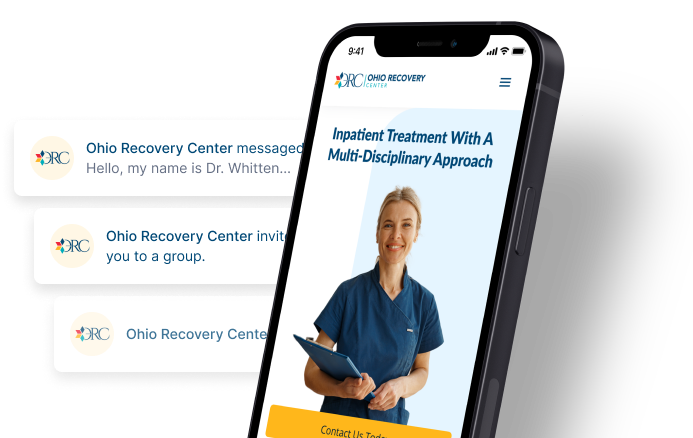Tramadol (Ultram) Addiction | Tramadol Abuse In Ohio

Medically Reviewed By: Kimberly Langdon, M.D.
Tramadol is an opioid pain medication that can be abused for its sedative side effects. Those taking tramadol may show signs of addiction, like intense cravings and flu-like symptoms when they’re not using, which may require professional treatment.

Tramadol (brand name Ultram) is an opiate narcotic analgesic pain medication. This prescription drug helps relieve moderate to severe pain.
As an opioid painkiller, tramadol is a Schedule IV controlled substance by the Drug Enforcement Administration (DEA) and has the potential for abuse. Tramadol is offered in an extended-release formulation as well.
Also used to treat chronic pain, tramadol affects the central nervous system (CNS) by interacting with opioid receptors in the brain. This provides pain relief but can also produce a number of side effects which may appeal to those wishing to partake in tramadol abuse.
Tramadol Abuse
There are a number of ways in which tramadol can be abused, including using the drug in high doses, administering it in ways other than prescribed, or combining it with other drugs or alcohol.
Taking Higher Doses
Those who do not take the medication as prescribed by their healthcare provider are participating in drug abuse. Taking larger doses of tramadol can lead to more serious side effects and increase your risk of a tramadol overdose.
Snorting/Injecting Tramadol
Some who abuse tramadol may turn to insufflation by crushing the pill and snorting the substance. When this takes place, a person may experience a stronger “high” or sedation.
Some may also try to abuse tramadol by injecting the drug into a vein in their body. The pill must first be crushed and combined with liquid before injected.The intensity of the euphoria and sedation increases rapidly when the drug is injected.
Polydrug Abuse
Another form of drug abuse is combining other medications with tramadol. Taking any of following substances with tramadol can increase side effects and increase the risk of health issues:
- opioids such as oxycodone or hydrocodone
- synthetic opioids such as fentanyl
- antidepressants such as selective serotonin re-uptake inhibitors (SSRIs), serotonin norepinephrine re-uptake inhibitors (SNRIs), or monoamine oxidase (MAO) inhibitors
- benzodiazepines
- Ultracet, which combines tramadol and acetaminophen (Tylenol)
- alcohol
- antihistamines
According to the Substance Abuse and Mental Health Services Administration (SAMHSA), when other CNS depressants are combined with tramadol, the sedative effects may be enhanced, leading to falls, accidents, drownings, and a higher risk of overdose.
Side Effects Of Tramadol Abuse
The side effects of tramadol abuse can range in severity.
Common Side Effects
According to the United States Food and Drug Administration (FDA), some of the side effects of tramadol may consist of:
- constipation
- drowsiness
- sedation
- headache
- nausea
- vomiting
- dizziness
When tramadol is abused, a person may experience a number of life-threatening side effects including loss of consciousness as well as fluctuations with blood pressure and heart rate.
Serotonin Syndrome
Serotonin syndrome is a life-threatening condition which can occur when certain medications and substances are combined. Certain antidepressants combined with tramadol may result in an excess of serotonin.
Some of the side effects of serotonin syndrome may include:
- blood pressure fluctuations
- vomiting
- nausea
- incoordination
- hyperthermia
- agitation
- hallucinations
- coma
Tramadol Withdrawal Symptoms
The use of tramadol for an extended period of time may lead to withdrawal symptoms if the medication is abruptly stopped. Tapering off the medication is likely preferred.
A person may experience withdrawal symptoms if they have a physical dependence to tramadol. Those with a tramadol dependence who abruptly stop taking the drug may develop withdrawal symptoms such as:
- cravings for the drug
- panic
- runny nose
- sleeping problems
- tremors
- diarrhea
- hallucinations
If you notice a family member continuing to experience these symptoms, it may be a sign of tramadol abuse or addiction.
Tramadol Overdose
Those struggling with tramadol abuse may be more likely to experience a tramadol overdose. Symptoms of an opioid overdose may include:
- unresponsiveness
- breathing problems
- cold or clammy skin
- small pupils
- slow heart rate
- muscle weakness
At the emergency room, healthcare professionals may administer naloxone, a medication used to help reverse the effects of a tramadol overdose.
Signs Of A Tramadol Addiction
There may be a number of signs associated with tramadol abuse that may be noticed by yourself or a loved one, including:
- Difficulty controlling tramadol use
- Intense cravings for tramadol or other opioids
- Frequent drowsiness or sedation
- Abrupt weight loss and changes in sleeping patterns
- Personal hygiene issues
- Prioritizing fining or using drugs over family, friends, and other relationships
- Financial issues
- Visiting multiple physicians for tramadol prescriptions (doctor shopping)
Additional signs of tramadol addiction include continuing to use drugs despite harmful consequences to personal relationships and professional/academic responsibilities. If you notice any signs of addiction in a loved one, professional treatment can help.
Tramadol Addiction Treatment
For those of you struggling with a drug addiction, consider finding an inpatient or outpatient treatment center that begins with medical detox support.
Medical Detox
One of the first steps of treatment involves detoxification. The detox process may only last short-term, depending on the severity of your condition. Tapering off the drug may be suggested as opposed to quitting abruptly.
Those suffering from withdrawal symptoms may be prescribed methadone or buprenorphine by their doctor to help ease symptoms of withdrawal. With detox, your body can rid itself of unwanted harmful toxins created by tramadol abuse.
Inpatient/Outpatient Treatment
Various treatment options may be available to you, including inpatient or outpatient care. Those seeking a structured environment with 24/7 access to medical professionals may choose inpatient treatment options. Outpatient care may be appropriate following inpatient treatment
Depending on the severity of your drug use, treatment programs may include medication-assisted treatment, behavioral therapy, mental health counseling, and peer support groups. To learn about the inpatient treatment options at Ohio Recovery Center, please contact us today.
FAQs
Does Tramadol Show Up On A Drug Test?
Tramadol does show up on some drug tests but it often needs to be an advanced drug screening. You may test positive on a urine drug screen for up to four days after last use if tramadol is specifically tested for.
Learn more about Drug Testing For Tramadol
How Much Does Tramadol Cost?
The cost of tramadol varies from location to location and may be influenced by brand name vs. generic formulations, discount cards or savings cards, assistance programs, and other factors.
As a general rule, a typical tramadol prescription will cost $10-20 dollars at a pharmacy using a valid prescription, or $1-10 per pill on the street.
Learn more about How Much Tramadol Costs
How Does Tramadol Affect Sex?
Tramadol negatively affects sex by decreasing sexual desire in both men and women and increasing the prevalence of erectile dysfunction in men. Some studies also suggest that tramadol can help treat premature ejaculation, but more research is likely needed.
Learn more about The Effects Of Tramadol On Sex
Can You Smoke Tramadol?
Tramadol is not commonly abused by smoking, as the medication does not easily vaporize and is largely lost in the process. More often, the drug is abused orally or through snorting, injection, or plugging.
Learn more about Smoking Tramadol
Is Rectal Tramadol Use Safe Or Effective?
While effective for a short-lived but intense high, rectal tramadol use may result in an increased risk of overdose and damage to the rectal tissue. As a method of abuse, tramadol can be crushed into a powder, combined with water, and inserted into the rectum in a process known as “plugging.”
Learn more about Plugging Tramadol
- Centers for Disease Control and Prevention — About CDC’s Opioid Prescribing Guideline https://www.cdc.gov/opioids/providers/prescribing/guideline.html
- Drug Enforcement Administration — Tramadol https://www.deadiversion.usdoj.gov/drug_chem_info/tramadol.pdf
- Food and Drug Administration — Ultram https://www.accessdata.fda.gov/drugsatfda_docs/label/2009/020281s032s033lbl.pdf
- National Library of Medicine: MedlinePlus — Tramadol https://medlineplus.gov/druginfo/meds/a695011.html
- Substance Abuse and Mental Health Services Administration — Emergency Department Visits For Drug Misuse Or Abuse Involving The Pain Medication Tramadol https://www.samhsa.gov/data/sites/default/files/report_1966/ShortReport-1966.pdf

